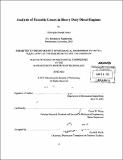| dc.contributor.advisor | Victor W. Wong. | en_US |
| dc.contributor.author | James, Christopher Joseph | en_US |
| dc.contributor.other | Massachusetts Institute of Technology. Dept. of Mechanical Engineering. | en_US |
| dc.date.accessioned | 2012-11-19T19:18:38Z | |
| dc.date.available | 2012-11-19T19:18:38Z | |
| dc.date.copyright | 2012 | en_US |
| dc.date.issued | 2012 | en_US |
| dc.identifier.uri | http://hdl.handle.net/1721.1/74921 | |
| dc.description | Thesis (S.M.)--Massachusetts Institute of Technology, Dept. of Mechanical Engineering, 2012. | en_US |
| dc.description | Cataloged from PDF version of thesis. | en_US |
| dc.description | Includes bibliographical references (p. 123-129). | en_US |
| dc.description.abstract | Fuel economy of large, on-road diesel engines has become even more critical in recent years for engine manufactures, vehicle OEMs, and truck operators, in view of pending CO2 emission regulations. Demands for increased fuel economy are coupled with corresponding improvements in engine performance, durability, and emissions. This project centers on resolving the adverse effects on engine wear, durability, emissions, and oil consumption that often accompany traditional low-friction concepts. A detailed analysis of the sources of friction within a heavy-duty diesel engine was undertaken and empirical data on engine friction and component wear was collected from industry as well as from studies in literature. The use of thermal barrier coatings (TBC) was investigated as a novel approach to strategically increase cylinder liner temperatures in order to reduce power cylinder friction. By coating selected parts of the liner where piston speeds are high, local liner temperature is raised and local lubricant viscosity decreased in that region. In the mid-stroke, the piston is in the hydrodynamic lubrication regime, and high surface speeds generate the majority of the power cylinder work losses which can be reduced through reduced lubricant viscosity. By coating the liner in selected regions only, top dead center temperatures are mostly unaffected thereby minimizing any increase in cylinder liner wear. This approach is expected to maximize friction reduction while minimizing risk to other engine components or increasing component wear rates. A simulation was developed to model the primary physical processes that occur in a complete four stroke engine cycle. Calculations included work done by the piston, mass flow rates through the intake and exhaust valves, heat release during combustion, and heat transfer rates. The results demonstrate the potential to decrease power cylinder between 15% and 30% depending on coating thickness and application zone. This corresponds to approximately a 0.5% to 1% improvement in vehicle fuel economy. Additional fuel economy benefits from the TBC are expected from increased exhaust gas enthalpy and reduced liner heat rejection. This strategic thermal management approach within the engine has very high potential to increase engine efficiency while maintaining the performance and durability demanded in the HD engine market. | en_US |
| dc.description.statementofresponsibility | by Christopher Joseph James. | en_US |
| dc.format.extent | 131 p. | en_US |
| dc.language.iso | eng | en_US |
| dc.publisher | Massachusetts Institute of Technology | en_US |
| dc.rights | M.I.T. theses are protected by
copyright. They may be viewed from this source for any purpose, but
reproduction or distribution in any format is prohibited without written
permission. See provided URL for inquiries about permission. | en_US |
| dc.rights.uri | http://dspace.mit.edu/handle/1721.1/7582 | en_US |
| dc.subject | Mechanical Engineering. | en_US |
| dc.title | Analysis of parasitic losses in heavy duty diesel engines | en_US |
| dc.type | Thesis | en_US |
| dc.description.degree | S.M. | en_US |
| dc.contributor.department | Massachusetts Institute of Technology. Department of Mechanical Engineering | |
| dc.identifier.oclc | 815732310 | en_US |
